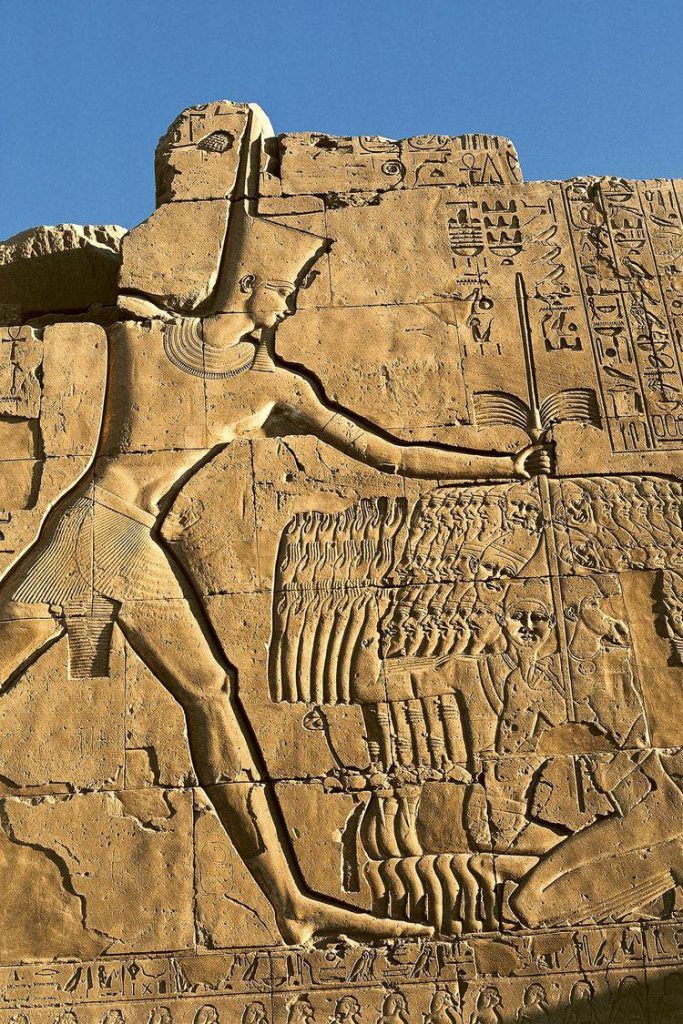Thutmose III, often hailed as the “Napoleon of Ancient Egypt,” reigned between 1479 and 1425 BCE and is widely celebrated as one of Egypt’s most accomplished warrior pharaohs. His remarkable leadership marked the pinnacle of the New Kingdom, elevating Egypt to unparalleled heights of military and cultural influence. Under his reign, Egypt’s borders expanded significantly, extending its power far beyond traditional limits. This era of prosperity and dominance is immortalized in intricate reliefs that depict Thutmose III as a commanding and strategic ruler, embodying strength and brilliance in equal measure.
Thutmose III’s journey to becoming one of Egypt’s most iconic leaders began under unique circumstances. Initially, he served as co-regent with his stepmother, Hatshepsut, who assumed the role of pharaoh during his early years. Hatshepsut’s reign laid a solid foundation for Egypt’s prosperity through ambitious trade expeditions and monumental temple constructions. Upon her death, Thutmose III seized full control, embarking on a transformative era characterized by military conquests and cultural advancements. His leadership not only honored the groundwork laid by Hatshepsut but also elevated Egypt’s status as a formidable military power.

As a warrior-pharaoh, Thutmose III’s legacy is defined by his remarkable military campaigns, which played a crucial role in expanding Egypt’s empire. Historical records document 17 military campaigns under his leadership, each demonstrating his unparalleled tactical expertise and strategic vision. His conquests stretched Egypt’s influence from the Mediterranean coast to the Euphrates River, creating an extensive network of vassal states that safeguarded Egypt’s borders and secured its trade routes. These territories served as both economic and military buffers, solidifying Egypt’s dominance in the ancient world.
Among his military achievements, the Battle of Megiddo stands out as a defining moment in Thutmose III’s career. This pivotal encounter showcased his ability to outmaneuver and outthink his adversaries. Employing a bold and unexpected strategy, he orchestrated a surprise attack that overwhelmed his enemies, securing a decisive victory. The triumph at Megiddo not only cemented Egypt’s military reputation but also established control over vital trade routes in the Levant. Thutmose III’s strategic brilliance during this campaign remains a hallmark of ancient military history, highlighting his exceptional leadership.
While his military prowess is often celebrated, Thutmose III’s contributions extended far beyond the battlefield. His reign also left an indelible mark on Egyptian architecture, with significant expansions to the Karnak Temple Complex. The Festival Hall at Karnak, one of his most notable architectural achievements, stands as a testament to his vision. This grand structure, adorned with elaborate reliefs, commemorates his military triumphs and underscores his divine authority as a ruler. Through these monumental projects, Thutmose III reinforced his legacy, ensuring that his achievements would be remembered for generations.
Thutmose III’s era also ushered in a golden age of economic prosperity and cultural exchange. The wealth amassed from his military campaigns enriched Egypt’s treasury, facilitating further advancements in art, architecture, and cultural endeavors. Trade flourished under his rule, bringing valuable goods and innovative ideas from distant regions into Egypt. This cultural influx not only enhanced Egypt’s material wealth but also solidified its reputation as a center of civilization. The period’s prosperity enabled the construction of more temples and artworks, reflecting the grandeur of Thutmose III’s reign.
The legacy of Thutmose III is deeply rooted in his ability to balance military conquests with cultural development and architectural innovation. His strategic foresight fortified Egypt’s borders and ensured its dominance over neighboring regions. At the same time, his patronage of the arts and dedication to monumental architecture left a lasting impression on Egypt’s cultural heritage. His accomplishments resonate through history, making him one of the most revered figures in ancient Egyptian lore.
In modern times, Thutmose III’s influence continues to captivate historians and archaeologists alike. His leadership represents the ideals of strength, wisdom, and strategic brilliance. The legacy of his reign offers valuable insights into the dynamics of power, culture, and governance in ancient Egypt. His ability to integrate military achievements with cultural enrichment serves as a model of balanced leadership, inspiring admiration across generations.
Thutmose III’s reign stands as a powerful symbol of Egypt’s golden age, encapsulating the essence of a civilization at its zenith. His military conquests, architectural contributions, and cultural advancements set the stage for an empire that would influence the ancient world for centuries to come. As a visionary leader, he exemplified the qualities that define greatness, leaving an enduring legacy that continues to inspire respect and admiration.
Through his strength on the battlefield, his architectural innovations, and his commitment to cultural growth, Thutmose III established himself as a pivotal figure in ancient history. His reign not only transformed Egypt into a dominant power but also laid the groundwork for its lasting cultural and historical impact. Today, he remains a symbol of Egypt’s might, prosperity, and enduring influence, securing his place among the pantheon of Egypt’s most celebrated pharaohs.





